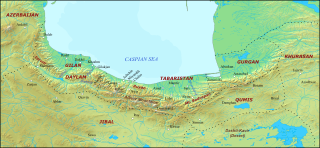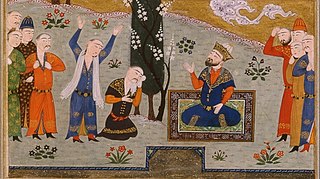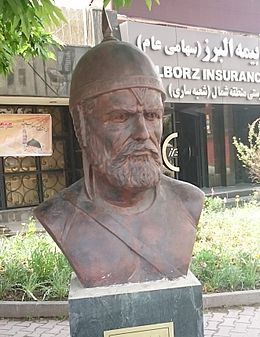
Abū Isḥāq Muḥammad ibn Hārūn al-Muʿtaṣim, better known by his regnal name al-Muʿtaṣim biʾllāh, was the eighth Abbasid caliph, ruling from 833 until his death in 842. A younger son of Caliph Harun al-Rashid, he rose to prominence through his formation of a private army composed predominantly of Turkic slave-soldiers. This proved useful to his half-brother, Caliph al-Ma'mun, who employed al-Mu'tasim and his Turkish guard to counterbalance other powerful interest groups in the state, as well as employing them in campaigns against rebels and the Byzantine Empire. When al-Ma'mun died unexpectedly on campaign in August 833, al-Mu'tasim was thus well placed to succeed him, overriding the claims of al-Ma'mun's son al-Abbas.

Bābak Khorramdin was one of the main Iranian revolutionary leaders of the Iranian Khorram-Dinān, which was a local freedom movement fighting the Abbasid Caliphate. Khorramdin appears to be a compound analogous to dorustdin "orthodoxy" and Behdin "Good Religion" (Zoroastrianism), and are considered an offshoot of neo-Mazdakism. Babak's Iranianizing rebellion, from its base in Azerbaijan in northwestern Iran, called for a return of the political glories of the Iranian past. The Khorramdin rebellion of Babak spread to the Western and Central parts of Iran and lasted more than twenty years before it was defeated when Babak was betrayed. Babak's uprising showed the continuing strength in Azerbaijan of ancestral Iranian local feelings.

Abdallah ibn Tahir was a military leader and the Tahirid governor of Khurasan from 828 until his death. He is perhaps the most famous of the Tahirids. His career spanned twenty-five years under three caliphs, al-Ma'mun, al-Mu'tasim, and al-Wathiq. Militarily, he is known for defeating the powerful rebels Nasr ibn Shabath in the Jazira and Ubaydallah ibn al-Sari in Egypt.

Ḥaydar ibn Kāwūs, better known by his hereditary title of al-Afshīn, was a senior general of Sogdian Iranian descent at the court of the Abbasid caliphs and a vassal prince of Oshrusana. He played a leading role in the campaigns of Caliph al-Mu'tasim, and was responsible for the suppression of the rebellion of Babak Khorramdin and for his battlefield victory over the Byzantine emperor Theophilos during the Amorium campaign. Eventually he was suspected of disloyalty and was arrested, tried and then executed in June 841.

The Bavand dynasty, or simply the Bavandids, was an Iranian dynasty that ruled in parts of Tabaristan in what is now northern Iran from 651 until 1349, alternating between outright independence and submission as vassals to more powerful regional rulers. They ruled for 698 years, which is the second longest dynasty of Iran after the Baduspanids.

Tabaristan or Tabarestan, was a mountainous region located on the Caspian coast of northern Iran. It corresponded to the present-day province of Mazandaran, which became the predominant name of the area from the 11th-century onwards.

The Dabuyid dynasty, or Gaubarid dynasty, was a Zoroastrian Iranian dynasty that started in the first half of the 7th century as an independent group of rulers that ruled over Tabaristan and parts of western Khorasan. Dabuyid rule over Tabaristan and Khorasan lasted from around 642 to the Abbasid conquest in 760.
Baha al-Din Muhammad ibn Hasan ibn Isfandiyar, commonly known as Ibn Isfandiyar, was a 13th-century Iranian historian from Tabaristan, who wrote a history of his native province, the Tarikh-i Tabaristan. What little is known of his life comes from the introduction of this work.

Farrukhan the Great was the independent ruler (ispahbadh) of Tabaristan in the early 8th century, until his death in 728. He defended his realm from the Umayyad Caliphate, who, under Yazid ibn al-Muhallab were defeated by Farrukhan, who laid ambush to his army. He took the titles Ispadbadh, Padashwargarshah and Gilgilan and defeated a Daylamite revolt to his west. The city of Sari, Iran and the Shahr E-Espohdban were founded under him, and he moved his capital there. He also spent much of his reign fighting the Dabuyid nobility, in which he was successful, and Farrukhan died in 728 with his son Dadhburzmihr succeeding him.

The Baduspanids or Badusbanids, were a local Iranian dynasty of Tabaristan which ruled over Ruyan/Rustamdar. The dynasty was established in 665, and with 933 years of rule as the longest dynasty in Iran, it ended in 1598 when the Safavids invaded and conquered their domains.
Sharwin I was the fifth ruler of the Bavand dynasty from 772 to 817. He was the son and successor of Surkhab II.
Shapur was the seventh ruler of the Bavand dynasty, who ruled briefly in 825. He was the son and successor of Shahriyar I.
Shahriyar I was the sixth ruler of the Bavand dynasty from 817 to 825. He was the grandson and successor of Sharwin I. Before Shahriyar became ruler of the Bavand dynasty, he was taken as hostage by Harun al-Rashid to Baghdad, where Shahriyar stayed for four years until he was allowed to return to Tabaristan.
Vindadhhurmuzd, also known by the more correct form of Vandad Hormozd, was the ruler of the Qarinvand dynasty from 765 to 809.
Qarin I, was the eighth ruler of the Bavand dynasty from 839 to 867.
Quhyar, was the ruler of the Qarinvand dynasty, ruling briefly in 839 until his assassination.

Abdallah ibn Khordadbeh was a Persian general and governor for the Abbasid Caliphate.

The Qarinvand dynasty, or simply the Karenids, was an Iranian dynasty that ruled in parts of Tabaristan (Mazandaran) in northern Iran from the 550s until the 11th-century. They considered themselves as the inheritors of the Dabuyid dynasty, and were known by their titles of Gilgilan and Ispahbadh. They were descended from Sukhra, a Parthian nobleman from the House of Karen, who was the de facto ruler of the Sasanian Empire from 484 to 493. The Qarinvand dynasty is also considered to be the one of the last Zoroastrian dynasties before the rise of the Islamic Iranian dynasties

Shah Ghazi Rustam, was king of the Bavand dynasty of Mazandaran, ruling from 1142 to 1165. He expanded the borders of the kingdom at the expense of his neighbors, particularly the Ismailis and the Seljuks. He established a Bavandid presence in Gilan as a result of his frequent vengeful raids against the Ismailis, who had assassinated his son and heir, Girdbazu. He also brought Qumis and Ray under Bavandid control during his wars against the Seljuks and the Karakhanids.













